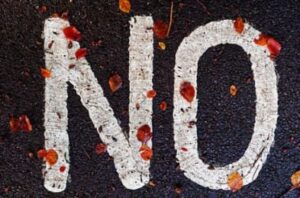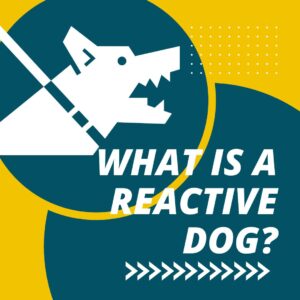There are many forms of reactivity in dogs, so what is a reactive dog? A reactive dog is one who ‘reacts’ when faced with a particular trigger that they dislike or are scared of.
What does it mean when a dog is reactive? The reaction from the dog is usually what we would term ‘bad’ or aggressive behaviour. The reaction is essentially communication which is designed to make the trigger go away. The feeling the dog is usually having is fear.
There can be other reasons for reactivity in dogs but a high percentage of reactivity is fear-based and if we assume that it’s fear then we will approach the dog with concern and compassion. By approaching each dog from this perspective we can ensure that we don’t do the dog any further harm.
In the course of your dog walking career, you may be asked to walk a reactive dog. You may even have owned a reactive dog, but not everyone has come across reactivity, know what it is or how to best deal with it.
The most common trigger for reactivity is other dogs. Other triggers can be unknown people (these are unlikely to book a dog walker!) or objects (usually fast-moving, cars, cyclists and joggers etc.)
The most important thing when exercising/walking a reactive dog is to avoid triggers.
Table of Contents
What causes reactive dogs?
There are many causes of reactivity. It’s not always down to improper socialisation as a puppy, and it’s not always because of a bad experience they’ve had, but sometimes it is. If we forget to introduce a dog to other dogs during their formative first 16 weeks then they can become fearful of dogs as an adult.
The type of reactivity is also linked to the breed. Border collies are more likely to be reactive to traffic, terriers are likely to dislike joggers and cyclists, German Shepherds are likely to be suspicious of strangers. Humans have bred certain traits into breeds over hundreds of generations which can turn into frustrated reactivity if not given an appropriate outlet.
Is my dog reactive or aggressive?
Aggressive behaviour is communication. Reactive dogs are likely to direct their aggression at their trigger but will redirect that aggression at times.
For example, if you’re walking a dog who is reactive to other dogs and your dog is acting aggressively in order to make the other dog go away, it’s possible that in their stressed state they may redirect their behaviour onto you if the situation isn’t managed correctly.
Reactivity can be mild or severe, but it’s wise to remember that all reactive dogs are not aggressive by nature. Reactive dogs are just having a hard time dealing with the situation that they’re in.

How to walk a reactive dog safely.
When a dog tips over their threshold and reacts, they are usually barking and lunging forward on the lead, or pulling backwards against the lead. It’s therefore really important that they’re walked on the correct equipment to keep them from escaping, but also from hurting themselves.
Dogs who pull backwards away from their triggers often wriggle out of harnesses and pull their heads out of collars. There are some escape proof harnesses available but owners can’t always afford them.
When dogs lunge forward they put a lot of strain on collars and harnesses, risking them breaking and also risking damage to their chest and neck areas.
A good walking set-up for reactive dogs has two points of attachment for leads. So one lead on the collar and one of a harness (or double-ended lead attached to both points). Smaller dogs that can be easily held during a reaction suit this set-up.
A better set-up is a head collar (Dogmatic is my go-to brand) and a harness. This takes all the pressure off the neck directly and makes the control of a larger dog possible even if you lack size and strength yourself. Dogs need to get used to headcollars at home first so that it doesn’t make their reactivity worse so you’ll need to work with the owners if you want to use one.
The best set-up is an escape-proof harness with the lead attachment on the chest area instead of the back, alongside a headcollar.
How to help a reactive dog
Hopefully, the dog’s owners are working with a behaviourist or trainer and are working on a plan to desensitise (get the dog used to seeing the trigger) and counter condition (get the dog to feel differently about the trigger) to help the dog. If they’re not I would highly recommend suggesting it gently to them. It’ll make your job easier and the dog’s life better if they get some help. Obviously don’t offer any advice, however well-meaning, unless you’re qualified, and insured, to do so.
Can a reactive dog be cured? Yes, improvements can be made with most dogs, and some dogs can be counter conditioned to such a point where they can be considered cured. As their dog walker, you can be a key component in that journey by providing stress-free exercise for those dogs.
As a dog walker, the best walk you can give the dog is one where they don’t feel the need to react to anything and that means avoiding all triggers. Unfortunately, other dog owners aren’t always familiar with reactive dogs.
- Walk in quiet areas where even if you meet a dog they’re likely to be on a lead. Onlead parks, cemeteries and road walks should give you enough space to see and avoid other dogs and reduce the risk of an offlead dog coming up to you. Avoid narrow paths/alleys where you can’t step far enough off to one side. (see our other article ‘where to walk a reactive dog‘ for more ideas)
- If your dog starts to react, increase the distance between you and the trigger immediately and quickly. Most trainers teach owners to use a quick turn and walk away as part of the training, so check with the owner if there’s a cue word to use in this situation.
- Try and stay calm, keep a tight hold of the lead and don’t say anything. Once a dog has gone over threshold and is reacting there’s nothing you can do to make it better for that dog except making the trigger go away. If the trigger is another dog, and you can’t walk away because he’s following, then your best action is to wait for the owner to collect their dog and then move away.
- Be aware that once the dog has reacted once they’ll be in a heightened state of stress and much more likely to react again even if their trigger is spotted from a further distance.

What not to do with a reactive dog.
- Never use equipment without the owner’s permission. Headcollars and muzzles need introducing to the dog slowly and they need to be trained to wear them. If you feel you need to use something to make your walks safer, or for you to have better control, discuss it with the owners.
- Never take unnecessary risks. If you’re having a nice calm walk and your dog seems okay and you think why not let him say hello to the friendly dog coming along the same path, that’s an unnecessary risk. Short on time and he’s been good on walks lately so why not take him out with another dog just this once? That’s an unnecessary risk.
- Never interfere with the owner’s training. If you disagree with the way the owner has asked you to manage the dog’s reactivity then just say that you don’t think you’re a good fit and let them find another walker.
Conclusion
Reactive dogs are just having a hard time with the environment they’re in. Just as some people are scared of spiders, some dogs are scared of other dogs, or people with beards, or cars.
Reactive dogs are usually amazing dogs at home, gentle, non-aggressive, family dogs. But they turn into a frenzied ball of anxiety when they see their triggers.
They deserve a nice walk just like any other dog, so when you’re walking your group of dogs please give dogs on leads some space.
Only take on dogs that you’re comfortable with and confident that you’d be able to control when they react. And when you get ‘that’ look from a member of the public who is lucky enough not to know what a reactive dog is, just smile and walk away.
